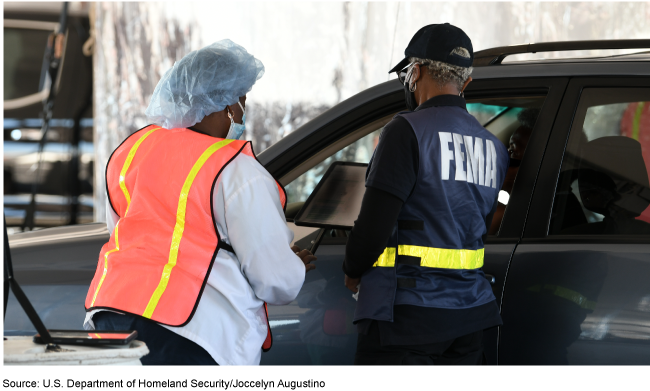FEMA: Opportunities to Help Address Mission and Management Challenges
Fast Facts
FEMA leads the federal response to weather and climate-related disasters. FEMA has also played a key role in the COVID-19 response, even as disasters have become more frequent. We testified that FEMA:
- Has staff shortages due in part to burnout
- Could better communicate about eligibility requirements for disaster programs
- Doesn't have data to determine whether there are social or institutional barriers to accessing disaster programs
- Uses flood maps that may not reflect the best available climate science or include information on current hazards
FEMA is working to address recommendations from our prior reports related to these challenges.
FEMA worker at COVID-19 vaccination site in February 2021

Highlights
What GAO Found
GAO's past work has identified various mission and management challenges the Federal Emergency Management Agency (FEMA) is facing in four key areas: (1) workforce management; (2) long-term disaster recovery efforts; (3) potential barriers to disaster assistance and disparate recovery outcomes; and (4) future disaster resilience and mitigation. For example:
Workforce management. GAO found that FEMA faced challenges with deploying staff with the right skills and training to best meet the needs of various disasters. For example, at the height of workforce deployments in October 2017, 54 percent of staff were serving in a capacity in which they were not qualified according to FEMA's qualification system standards. GAO recommended that FEMA develop a plan to address challenges that have hindered FEMA's ability to provide reliable and complete information to field leaders about staff abilities. FEMA told GAO in December 2021 that it is developing qualification plans to better inform field leaders about staff knowledge, skills and abilities.
Long-term recovery. GAO found that opportunities exist to improve survivors' understanding of FEMA's eligibility and award determinations for the Individual and Household Program, which provides housing and other needs assistance. For example, GAO recommended providing more information to survivors about their eligibility for assistance and clarifying that an ineligible determination is not always final but may mean FEMA needs more information to decide the award. As of fall 2021, FEMA was planning to revise its communications to survivors.
Potential barriers to assistance and disparate recovery outcomes. GAO reported that six federal disaster recovery programs had taken some actions to address social and institutional barriers, but these programs generally lacked quality information to identify potential access barriers and disparate recovery outcomes. GAO recommended that FEMA work with federal partners to develop and implement an interagency plan to help ensure the availability and use of quality information. FEMA is planning to address the recommendation by the end of 2022.
Disaster resilience and mitigation. GAO found that FEMA had developed more flood maps and other flood risk products, but the agency faced challenges ensuring they comprehensively reflected current and future flood hazards, such as heavy rainfall and the best available climate science. FEMA was addressing some of these challenges, but was operating under an out-of-date plan that did not include new goals or objectives. GAO recommended that FEMA update its plan to address challenges in reflecting current and future flood hazards. FEMA is working to address GAO's recommendation by the end of 2022.
GAO will continue to monitor FEMA's actions and assess the extent to which these actions address GAO's recommendations.
In light of more frequent and costly disasters, and with FEMA supporting numerous efforts outside of its normal core responsibilities, FEMA could continue taking actions to strengthen its mission and management operations.
Why GAO Did This Study
FEMA leads our nation's efforts to prepare for, protect against, respond to, recover from, and mitigate against the risk of disasters. In recent years, the increasing frequency and costs of disasters, the COVID-19 pandemic, and other responsibilities have placed additional pressures on FEMA.
This testimony discusses GAO's prior work and recommendations related to FEMA's challenges in four key areas: (1) workforce management; (2) long-term disaster recovery efforts; (3) potential barriers to disaster assistance and disparate recovery outcomes; and (4) future disaster resilience and mitigation.
This statement is based on products GAO developed and issued from January 2015 to December 2021. For those products, GAO reviewed and analyzed federal law, federal data, post-disaster contracts, agency guidance, and other agency documentation and interviewed federal, state, and local officials as well as representatives of stakeholder groups impacted by disasters. GAO also conducted some of these interviews as part of visits to locations affected by hurricanes in 2017 and 2018. Additionally, GAO conducted 17 focus groups with FEMA staff.
Recommendations
GAO has made numerous recommendations in prior reports designed to address the various mission and management challenges discussed in this testimony. FEMA has taken steps to address these recommendations and GAO is monitoring FEMA's ongoing efforts.
